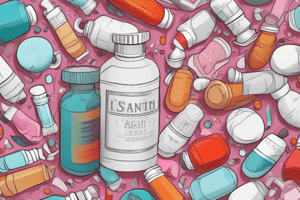Podcast
Questions and Answers
What role do enzyme inducers like carbamazepine play in relation to acetaminophen toxicity?
What role do enzyme inducers like carbamazepine play in relation to acetaminophen toxicity?
- They completely neutralize the effects of acetaminophen.
- They have no effect on acetaminophen toxicity.
- They decrease the hepatotoxicity of acetaminophen.
- They increase hepatotoxicity of acetaminophen. (correct)
Which patient conditions are most likely to increase the risk of acetaminophen toxicity?
Which patient conditions are most likely to increase the risk of acetaminophen toxicity?
- Chronic ethanol abuse and good nutrition.
- High protein intake and regular exercise.
- Obesity and advanced age.
- HIV infection and low glutathione reserve. (correct)
What is the mechanism that leads to respiratory alkalosis in aspirin toxicity?
What is the mechanism that leads to respiratory alkalosis in aspirin toxicity?
- Increased carbon dioxide levels in the blood
- Inhibition of renal acid excretion
- Overproduction of bicarbonate
- Activation of the respiratory center in the brain (correct)
What are the initial symptoms of aspirin poisoning?
What are the initial symptoms of aspirin poisoning?
What is the most effective time frame for administering N-acetylcysteine (NAC) as an antidote to paracetamol ingestion?
What is the most effective time frame for administering N-acetylcysteine (NAC) as an antidote to paracetamol ingestion?
Which mechanism describes how N-acetylcysteine (NAC) acts as an antidote?
Which mechanism describes how N-acetylcysteine (NAC) acts as an antidote?
How does chronic aspirin poisoning lead to metabolic acidosis?
How does chronic aspirin poisoning lead to metabolic acidosis?
Which statement best describes the blood pH during metabolic acidosis?
Which statement best describes the blood pH during metabolic acidosis?
What is the initial general measure taken in the management of acetaminophen toxicity?
What is the initial general measure taken in the management of acetaminophen toxicity?
What is the approximate mortality rate associated with acute aspirin poisoning?
What is the approximate mortality rate associated with acute aspirin poisoning?
What condition may result from chronic aspirin usage and is characterized by decreased arterial levels of carbon dioxide?
What condition may result from chronic aspirin usage and is characterized by decreased arterial levels of carbon dioxide?
Which effect does salicylate exposure have on renal function?
Which effect does salicylate exposure have on renal function?
What is a notable neurological symptom resulting from acute salicylism?
What is a notable neurological symptom resulting from acute salicylism?
What is the first phase of clinical manifestations after acetaminophen ingestion?
What is the first phase of clinical manifestations after acetaminophen ingestion?
Which management option is unsuitable for treating acute acetaminophen toxicity?
Which management option is unsuitable for treating acute acetaminophen toxicity?
What percentage of acetaminophen is excreted unchanged in urine?
What percentage of acetaminophen is excreted unchanged in urine?
Which of the following is a late clinical manifestation of an overdose?
Which of the following is a late clinical manifestation of an overdose?
What causes hepatic necrosis during acetaminophen overdose?
What causes hepatic necrosis during acetaminophen overdose?
What is the role of sulfhydryl compounds like N- Acetylcysteine (NAC) in acetaminophen poisoning?
What is the role of sulfhydryl compounds like N- Acetylcysteine (NAC) in acetaminophen poisoning?
How does metabolic saturation affect paracetamol toxicity?
How does metabolic saturation affect paracetamol toxicity?
What is a possible outcome if acetaminophen toxicity is left untreated?
What is a possible outcome if acetaminophen toxicity is left untreated?
Flashcards
What is an analgesic?
What is an analgesic?
A drug that reduces pain, often used for mild to moderate pain, fever, and inflammation.
What is salicylism?
What is salicylism?
A state of poisoning caused by excessive intake of aspirin (acetylsalicylic acid).
What is acute aspirin poisoning?
What is acute aspirin poisoning?
A single, large dose of aspirin can lead to immediate poisoning and potentially fatal consequences.
What is chronic aspirin poisoning?
What is chronic aspirin poisoning?
Signup and view all the flashcards
What are the key mechanisms of aspirin toxicity?
What are the key mechanisms of aspirin toxicity?
Signup and view all the flashcards
What is respiratory alkalosis in the context of aspirin poisoning?
What is respiratory alkalosis in the context of aspirin poisoning?
Signup and view all the flashcards
What is metabolic acidosis in the context of aspirin poisoning?
What is metabolic acidosis in the context of aspirin poisoning?
Signup and view all the flashcards
What are some symptoms of significant aspirin poisoning?
What are some symptoms of significant aspirin poisoning?
Signup and view all the flashcards
Acetaminophen Toxicity
Acetaminophen Toxicity
Signup and view all the flashcards
Cytochrome P450
Cytochrome P450
Signup and view all the flashcards
Glucuronidation
Glucuronidation
Signup and view all the flashcards
Glutathione (GSH)
Glutathione (GSH)
Signup and view all the flashcards
N-Acetylcysteine (NAC)
N-Acetylcysteine (NAC)
Signup and view all the flashcards
Phase 1 of Acetaminophen Toxicity
Phase 1 of Acetaminophen Toxicity
Signup and view all the flashcards
Phase 2 of Acetaminophen Toxicity
Phase 2 of Acetaminophen Toxicity
Signup and view all the flashcards
Phase 3 of Acetaminophen Toxicity
Phase 3 of Acetaminophen Toxicity
Signup and view all the flashcards
Enzyme inhibitors and acetaminophen toxicity
Enzyme inhibitors and acetaminophen toxicity
Signup and view all the flashcards
Enzyme inducers and acetaminophen toxicity
Enzyme inducers and acetaminophen toxicity
Signup and view all the flashcards
Low glutathione reserves and acetaminophen toxicity
Low glutathione reserves and acetaminophen toxicity
Signup and view all the flashcards
Competing for metabolic pathways: Acetaminophen toxicity
Competing for metabolic pathways: Acetaminophen toxicity
Signup and view all the flashcards
N-acetylcysteine (NAC) as antidote for acetaminophen overdose
N-acetylcysteine (NAC) as antidote for acetaminophen overdose
Signup and view all the flashcards
Study Notes
Analgesic Toxicity
- Analgesics, specifically aspirin and paracetamol, are the most common pharmaceutical agents involved in overdoses.
- Aspirin poisoning, also known as salicylism, involves acetylsalicylic acid. Its uses include antiplatelet effects, mild to moderate pain relief, anti-inflammatory properties, and fever reduction.
- Acute aspirin poisoning can result from a single overdose, with a 2% mortality rate, potentially inducing respiratory alkalosis followed by metabolic acidosis.
- Chronic aspirin poisoning occurs from prolonged high-dose use, exhibiting a 25% mortality rate, often more severe in children.
- Aspirin toxicity mechanisms involve the inhibition of oxidative phosphorylation, resulting in metabolic acidosis. Increased renal bicarbonate excretion is another characteristic effect. This leads to symptoms like nausea, vomiting, diaphoresis, tinnitus, deafness, vertigo, agitation, delirium, and hallucinations. Initially, respiratory alkalosis is prominent.
Paracetamol Toxicity
- Acetaminophen, a common analgesic, is generally safe, but a significant overdose can lead to acute hepatic necrosis (fatal).
- Daily intake of more than 4 grams over two weeks can induce toxicity.
- Acetaminophen poisoning causes about half the acute liver failures in the U.S.
- The metabolism of acetaminophen involves primarily hepatic glucuronidation and sulfation pathways to form inactive metabolites, with a smaller percentage being excreted unchanged.
- In overdose situations, the cytochrome P450 pathway becomes significant, creating NAPQI, a highly reactive metabolite that damages liver cells unless counteracted with glutathione.
- Acetaminophen toxicity is a saturation example of deactivation pathways. Excessive dosage depletes hepatic glutathione, binding the reactive metabolite to macromolecules, leading to hepatic necrosis.
- Early administration of sulfhydryl compounds like N-acetylcysteine (NAC) prevents liver damage.
- Paracetamol poisoning is characterized by three phases:
- Phase 1: (few hours to 24 hours): Nausea, vomiting, diaphoresis (sweating).
- Phase 2: (1-3 days): Elevated liver enzymes, increased serum bilirubin, pain.
- Phase 3: (3-5 days): Hepatic necrosis and encephalopathy; serious liver failure can develop within 4 to 5 days if hepatic damage is severe, leading to death.
Factors Affecting Paracetamol Toxicity
- Enzyme inhibitors, like omeprazole, decrease the hepatotoxicity of acetaminophen.
- Enzyme inducers, such as carbamazepine, increase the hepatotoxicity of acetaminophen.
- Patients with low glutathione reserves, due to factors like chronic alcohol abuse, fasting, malnutrition, or HIV infection, are at higher risk for paracetamol toxicity.
- Competition for glucuronidation pathways (e.g., sulfa drugs and azathioprine) can increase the likelihood of toxicity.
Management
- General measures (within 2 hours): Gastric lavage and activated charcoal.
- Specific measures: Intravenous fluids and infusions involving sodium bicarbonate (NaHCO3) to correct acidosis and enhance the elimination of paracetamol through the urine are preferred treatments.
- Antidote: N-acetylcysteine (NAC) – most effective within the first 8 hours.
NAC (N-acetylcysteine)
- NAC acts as an antidote by providing sulfhydryl donors to NAPQI to detoxify it.
- It acts as a precursor to cysteine, supporting glutathione production.
- It enhances sulfation of remaining acetaminophen.
- It acts as a free radical scavenger, enhancing oxygen uptake.
Studying That Suits You
Use AI to generate personalized quizzes and flashcards to suit your learning preferences.




